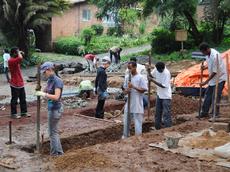Sustainable exchange
For nearly two weeks 18 students from ETH Zurich have been at the "ETHiopia Summer School" in Addis Ababa, where they've teamed up with Ethiopian students to work on a sustainable house at the "Ethiopian Institute of Architecture, Building Construction and City Development" - so far with extremely encouraging results indeed.

All budding architects, environmental scientists or economists, 18 bachelor, masters and PhD students from different disciplines were selected for the “ETHiopia Summer School” – an exchange program initiated by ETH Zurich and the Ethiopian Institute of Architecture, Building Construction and City Development (EiABC) complete with seminars, lectures and practical projects.
The Zurich students are guests at the EiABC, an autonomous institute under the umbrella of Addis Ababa University, for three weeks in all. They have teamed up with Ethiopian students to build the prototype of a SUDU (sustainable urban dwelling unit) with the help of lecturers, project developers and local construction workers. Made out of local materials, the SUDU is expected to offer the poorer population of Ethiopia an alternative form of housing to the slums that is easy to build.
Major challenges
The exchange is meant to highlight and address feasible solutions for the problems the government representatives of the East African nation will have to face in years to come. The population of Ethiopia is set to grow by 45 million in the next 15 years, for instance. The capital, Addis Ababa, needs to be redeveloped and new cities created – a huge challenge, especially since 75 percent of the population don’t even have access to clean drinking water as it is.
“The Ethiopians welcomed us with open arms”, says participant Lindsay Howe, reporting on her experiences so far. “More than anything, they’ve taught us how to build sustainably and cost-effectively under the given circumstances”. The intensive collaboration and communication with all those involved – from the professors to the day labourers – has already helped her immensely, both professionally and personally.
The first week was mainly devoted to lectures on the socio-economic and infrastructural requirements in Ethiopia, local building materials and pioneering construction techniques. “It was a wonderful opportunity for my Ethiopian students to learn alongside the Swiss students. We have never had such a wealth of knowledge here at the institute in one go”, beams Dirk Hebel, the science director of the EiABC and former senior assistant at ETH Zurich’s Faculty of Architecture.
The second and third weeks are more about the practical implementation of the SUDU project in three workgroups: architecture, water and sanitation, and entrepreneurship.
Interdisciplinary teamwork
The first group, the architects, learn how to make the materials for the house at four stations on the SUDU building site. Mostly using hard-packed clay, the technique hardly requires any cement to be added – a building material that the Ethiopians have to import with foreign currency. And thanks to an idea by ETH-Zurich assistant professor Philippe Bock, the round arches of the SUDU house made of pressed and dried clay tiles require very little cement and no scaffolding.
Meanwhile, the second workgroup – water and sanitation – is busy designing a system for the SUDU’s supply and waste disposal and, if there’s enough time, build it. The goal of the third group, entrepreneurship, is to market the clay tiles and the arch.
The prototype won’t be completed within the scheduled three weeks after all. However, that’s not due to a lack of effort on the part of those involved, but the fact that it has been raining a lot more than usual in Addis Ababa and it’s very humid, which means the clay isn’t drying out as quickly as it should.
Knowledge transfer the focus
However, even if the Zurich students can only build part of the house, for Lindsay Howe the SUDU project has been, “A process where we’ve learnt a lot about communication and building in Ethiopia and that more than anything else you need a lot of patience.” Moreover, for her and the other students from ETH Zurich being part of this project that has so much potential was extremely important and a great feeling. “We’ve already got some suggestions as to what we could improve in the future”. If there’s a follow-up to the Summer School, that is. And the students aren’t the only ones who hope so. As Lindsay Howe puts it, “It would be wonderful if we could exchange interdisciplinary information and technology on a regular basis and the Ethiopian students could come to Zurich one day.”
For Dirk Hebel, too, the Summer School is about far more than sustainable construction: “It’s all about the sustainability of knowledge exchange and the SUDU is an ideal vehicle to promote just that.”
ETHiopia Summer School
The ETHiopia Summer School is an exchange programme that was initiated by ETH Zurich and the Ethiopian Institute of Architecture, Building Construction and City Development (EiABC) in Addis Ababa. ETH Sustainability, the North-South Centre and ETH Zurich’s Faculty of Architecture are also involved in the project.







READER COMMENTS